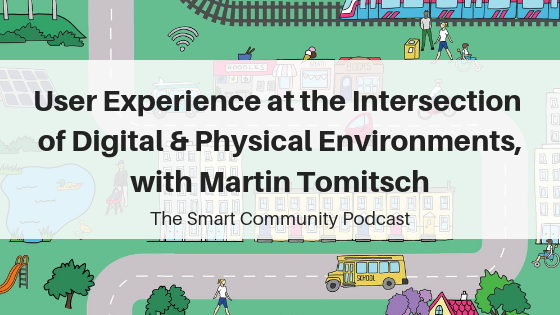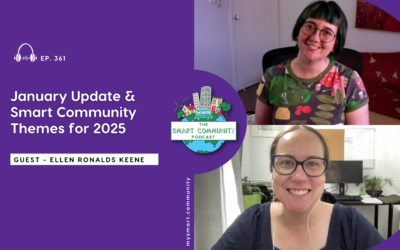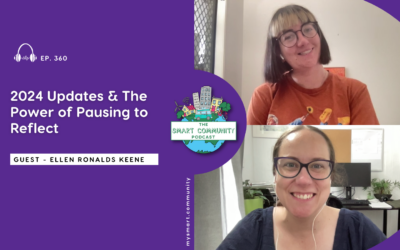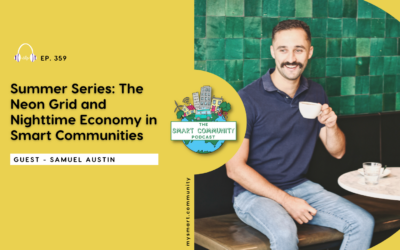In this episode of the Smart Community Podcast, Zoe speaks with Martin Tomitsch, Associate Professor in Design at the University of Sydney School of Architecture, Design and Planning, Chair of Design, and Research Director of the Design Lab – an interdisciplinary research group that investigates the role of design across a range of domains and contexts. Martin shares with Zoe the concepts of media architecture and hybrid infrastructure and how it can improve the lives of citizens in Smart Communities, as well as the importance of user experience design principles when designing Smart Cities. Martin tells us about his new book, “Making Cities Smarter, Designing Interactive Urban Applications” and some interesting projects designed to use emerging technologies to in one case reduce litter, and in another case make traffic lights not only fun, but safer. Zoe and Martin finish their conversation discussing the emerging trends of bio design, and cathedral thinking, and why we should be thinking long term when it comes to Smart Cities and Communities. As always we hope you enjoy listening to this episode as much as we enjoyed making it.
By the way, if you want to hear more from Zoe about her trip, you should subscribe to her exclusive podcast about her Churchill Fellowship. It’s exclusively for her supporters on Pozible, so head to Pozible.com today, search for My Smart Community, and hit support. There’s several episodes there already for you to get stuck into and hear Zoe’s insights from the various people, places and platforms she’s been exploring as part of her Churchill Fellowship. Now, on with the episode!
Listen here:
What we cover in this episode:
- Martin’s background in informatics and how his PhD in the intersection of digital and physical environments led to his interest in Smart Cities
- The concepts of media architecture and hybrid infrastructure, and how it can improve the lives of citizens in Smart Communities
- The label of Smart Cities and why Martin believes the global discourse about the concept is important
- How we can define “better” cities, and what “better” means
- The importance of user experience design principles when designing Smart Cities
- Martin’s new book, “Making Cities Smarter, Designing Interactive Urban Applications”, based on the UX design principles used in Smart City apps to help people in their daily lives
- The advantages of working as a research at a University
- The TetraBIN project designed to use emerging technologies to reduce litter in cities
- Places Martin has researched that are embracing Smart Concepts in ways that use user-centre approaches, including Amsterdam and Montreal
- The Street Pong project designed to make traffic lights not only more fun but also safer
- The role of design thinking and education in better integrating across multiple disciplines
- How Martin’s University are encouraging interdisciplinary collaboration and communication
- The emerging trend of biodesign and how shoe company Puma is using it in their shoes
- Cathedral thinking, “More than Human” design, and how we should be thinking long term when it comes to Smart Cities and Communities
Quotes:
“Smart Cities as a term was really successful in terms of getting buy in and starting a discourse, and for me the way the term is being used is about using technologies to enable Cities, governments or city councils, to make better use of the city infrastructure and to design better cities in many ways. Then it comes down to how do we define ‘better’? Is that more efficient and more effective cities, or are they talking also about the quality of life in cities and maybe about economic values as well?”
“The Smart Cities movement globally [has] actually made a lot of resources available to city governments and councils, so they started to have access to the resources and being able to more easily implement or change processes with the councils.”
“User experience design is really important because technology is really infiltrating all aspects of our lives and all levels of companies, so user experience design ensures that those technologies are designed in a way so that they’re actually meaningful, intuitive and easy to use but actually also addressing people’s needs… How can we translate those user experience design principles into cities, and into frameworks for designing Smart Cities”
“For me, city apps are really what is the interface between people and Smart Cities.”
[On Street Pong] “There’s research that shows that if you give that information [about how long until the traffic lights change] to people, they’re actually less likely to walk across the road when there’s a red light. It’s a clever way of using data…and making it available in a very playful way.”
“At the university, cross-disciplinary interaction or collaboration is really encouraged now and it’s something that’s seen in a positive way. So that contributes to this mind and attitude shift [towards collaboration], which is really important.”
“If we talk about the future of cities, I think what’s really critical is that we understand the role of education in all of this, because those people who are going through high school and university right now, they will be the leaders, whether it’s in industry or government or research of the future.”
“So for me as an educator at the university it’s really important that we’re teaching students now already of the importance of interdisciplinary collaboration. That involves not just aspects like teamwork and understanding of the other cultures and disciplinary areas, but also having a bit of a knowledge across a range of disciplines.”
“You get people with a background in biology or science to work together with designers, to better understand how these new technologies can be applied.”
Links:
Martin’s new book https://www.booktopia.com.au/making-cities-smarter-martin-tomitsch/prod9783868594928.html
The bin that lets you play tetris: TetraBIN http://www.tetrabin.com/#!vision.html
The Sencity company that is now developing TetraBIN https://sencity.city/tetrabin
Montreal Light Festival https://www.montrealenlumiere.com/
Street Pong http://www.streetpong.info/
Puma biodesign shoe https://design.mit.edu/projects/puma-biodesign
Marcus Foth episode https://mysmart.community/2018/02/26/e04/
Connect:
Connect with Martin on Twitter @martintom, LinkedIn @martintomitsch
Connect with me via email: hello@mysmart.community
Connect with My Smart Community via LinkedIn or Twitter and watch on YouTube
Podcast Production by Perk Digital






0 Comments